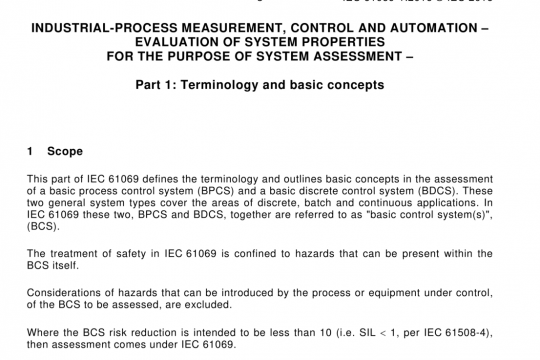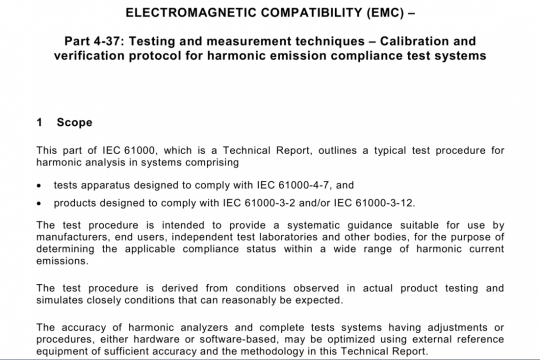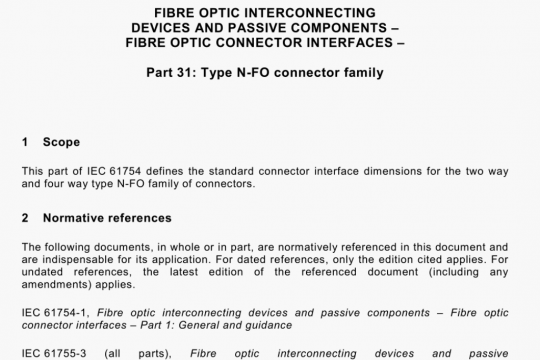IEC 61788-23 pdf free download
IEC 61788-23 pdf free download.Superconductivity – Part 23: Residual resistance ratio measurement – Residual resistance ratio of cavity-grade Nb superconductors.
The cryostat shall include a liquid helium reservoir at the bottom of a substantial vertical column. A support structure shall accommodate the raising and lowering of the sample into or out of the helium bath. In addition, anchoring of the sample position, either when immersed in liquid helium or suspended above the surface of the liquid at an arbitrary height, shall be provided. Such suspension permits the equilibration of temperature during measurement and slow increase of temperature with height above the helium bath. Alternatively, immersion of the sample into the bath followed by reduction of the bath level via boil-off or pressurized transfer can also be used to vary temperature.
A heater may be employed to warm the mandrel or base plate. The heater should be distributed along the mandrel and excessive power settings should be avoided. For instance, a point source of 1 W heat input operating at the centre of a 1 cm2 mandrel upon which a 5 cm sample is mounted could produce thermal gradients of 2,5 K along the sample if the thermal conductivity is 100W m1 K1.
Proper cryogenic techniques shall be followed for the construction of the cryostat and apparatus. This includes the use of low thermal conductivity materials such as thin-walled stainless steel tubes, composite materials, ceramics, and insulation, to prevent excessive boil-off due to heat conduction from the surroundings. A can or shield may surround the base plate or mandrel with mounted sample to improve thermal stability. Provisions for pressure relief and vacuum isolation of the liquid helium should be incorporated with the apparatus.
6 Specimen preparation
High-purity niobium is quite malleable, and even the slightest force can produce deformation of the material. Since dislocations are one source of electron scattering, specimen deformation can inadvertently contribute to the residual resistivity and affect the test result. Therefore, special protocols shall be observed when preparing the specimen. Cutting techniques shall avoid heat and strain to the extent possible. Discharge machining, fluid-jet cutting, or low-speed conventional machining are acceptable and widely-used techniques for applications using high- purity niobium. Specimens cut from larger pieces shall be protected and immobilized against a support piece during transport. Operations to de-burr samples shall not bend, excessively heat or otherwise damage the sample. Light sanding with fine paper is one acceptable approach.
Specimens should be rectangular or circular bars with uniform cross-section. Long sides of the specimen shall be parallel. Any twisting or curvature shall be avoided to ensure that bending or torsion is not applied to the test specimen during mounting to the mandrel or base plate. Specimens that form an arc or a U shape are acceptable provided that the entire curvature can be supported on a plane, without applying torsion to the bent specimen.
The specimen shall be clean and have no trace of residues from cutting fluids or any other surface contaminants. Degreasing with solvents, followed by ultrasonic cleaning using a mild water-based detergent, followed by rinsing with distilled or ultra-pure water, then drying in air, is preferred for cleaning residues. Chemical etching to clean the surface poses a risk of introducing contaminants, especially hydrogen and oxygen, and should be avoided. Gentle mechanical polishing of the regions where voltage taps and current leads attach is usually sufficient to remove surface oxides. Coating these regions with indium foil or another metal, for example by evaporation or sputtering, is an acceptable method to protect polished contacts provided that coating the entire specimen is avoided.
The test specimen shall be a single piece and shall not include any joints or splices.
A mechanical method shall be used to affix the test specimen to the mandrel or base plate. Installation and instrumentation of the specimen shall not apply excessive force, bending strain, tensile strain, or torsion to the specimen.IEC 61788-23 pdf download.




